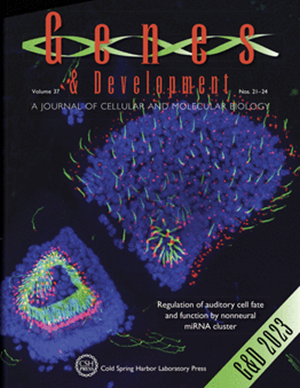MdfA是一种新型的ClpC接头蛋白,在发育中的枯草芽孢杆菌孢子中起作用
IF 7.7
1区 生物学
Q1 CELL BIOLOGY
引用次数: 0
摘要
细菌蛋白质降解机制由伴侣-蛋白酶复合物组成,它在细菌生长和发育中起着至关重要的作用,并引发了人们对新型抗菌靶点的兴趣。ClpC-ClpP (ClpCP)是一种这样的伴侣-蛋白酶复合物,在模式细菌枯草芽孢杆菌和其他革兰氏阳性细菌(包括病原体金黄色葡萄球菌和结核分枝杆菌)中被受体募集到特定功能。在这里,我们已经确定了一个新的ClpCP接头蛋白,MdfA(代谢分化因子a;原YjbA),在基因筛选中帮助枯草芽孢杆菌在孢子形成过程中进入代谢休眠的因素。敲除mdfA会刺激发育孢子中的基因表达,而在营养生长过程中mdfA的异常表达是有毒的。MdfA直接与ClpC结合,诱导其寡聚化和atp酶活性,这种相互作用是MdfA体内效应所必需的。最后,共晶结构揭示了MdfA与ClpC n端结构域结合的位置类似于结核分枝杆菌ClpC1蛋白上杀菌环肽结合的位置。总之,我们的数据和Riley及其同事的伴随研究支持MdfA诱导发育中的孢子中clpcp介导的代谢酶降解的模型,帮助将其推向代谢休眠。本文章由计算机程序翻译,如有差异,请以英文原文为准。
MdfA is a novel ClpC adaptor protein that functions in the developing Bacillus subtilis spore
Bacterial protein degradation machinery consists of chaperone–protease complexes that play vital roles in bacterial growth and development and have sparked interest as novel antimicrobial targets. ClpC–ClpP (ClpCP) is one such chaperone–protease complex, recruited by adaptors to specific functions in the model bacterium Bacillus subtilis and other Gram-positive bacteria, including the pathogens Staphylococcus aureus and Mycobacterium tuberculosis. Here we have identified a new ClpCP adaptor protein, MdfA (metabolic differentiation factor A; formerly YjbA), in a genetic screen for factors that help drive B. subtilis toward metabolic dormancy during spore formation. A knockout of mdfA stimulates gene expression in the developing spore, while aberrant expression of mdfA during vegetative growth is toxic. MdfA binds directly to ClpC to induce its oligomerization and ATPase activity, and this interaction is required for the in vivo effects of mdfA. Finally, a cocrystal structure reveals that MdfA binds to the ClpC N-terminal domain at a location analogous to that on the M. tuberculosis ClpC1 protein where bactericidal cyclic peptides bind. Altogether, our data and that of an accompanying study by Riley and colleagues support a model in which MdfA induces ClpCP-mediated degradation of metabolic enzymes in the developing spore, helping drive it toward metabolic dormancy.
求助全文
通过发布文献求助,成功后即可免费获取论文全文。
去求助
来源期刊

Genes & development
生物-发育生物学
CiteScore
17.50
自引率
1.90%
发文量
71
审稿时长
3-6 weeks
期刊介绍:
Genes & Development is a research journal published in association with The Genetics Society. It publishes high-quality research papers in the areas of molecular biology, molecular genetics, and related fields. The journal features various research formats including Research papers, short Research Communications, and Resource/Methodology papers.
Genes & Development has gained recognition and is considered as one of the Top Five Research Journals in the field of Molecular Biology and Genetics. It has an impressive Impact Factor of 12.89. The journal is ranked #2 among Developmental Biology research journals, #5 in Genetics and Heredity, and is among the Top 20 in Cell Biology (according to ISI Journal Citation Reports®, 2021).
 求助内容:
求助内容: 应助结果提醒方式:
应助结果提醒方式:


